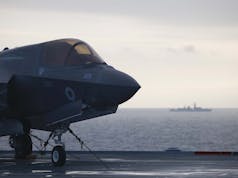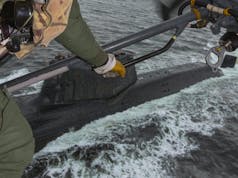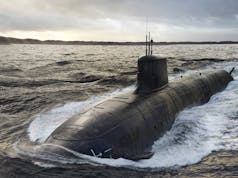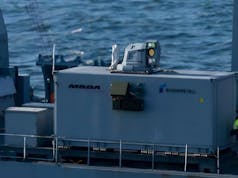HMS Richmond has been conducting gunnery training as part of the ongoing Carrier Strike Group 25 (CSG25) deployment.
In a social media update, the Royal Navy warship stated: “More gunnery practice today. It’s all about controlled aggression. We’re sharp, we’re accurate, and we’re ready to respond.”
The exercise, conducted under the banner of Operation Highmast, highlights the importance of maintaining combat effectiveness during the Carrier Strike Group’s global mission.
More gunnery practice today. It’s all about controlled aggression. We’re sharp, we’re accurate, and we’re ready to respond.@COMUKCSG #RoyalNavy#Gunnery#OpHighmast#CSG25 pic.twitter.com/o5j0EM195J
— HMS Richmond (@HMS_Richmond) May 7, 2025
Operation Highmast is the UK’s headline global deployment for 2025, involving the Royal Navy’s Carrier Strike Group led by HMS Prince of Wales. The deployment aims to enhance interoperability with allied navies and demonstrate the UK’s commitment to global maritime security. The operation includes a series of multinational exercises and joint training missions, covering regions including the Mediterranean, Indo-Pacific, and other areas of strategic importance.
The Carrier Strike Group 25 consists of various assets, including surface combatants, a submarines and of course aircraft. The mission focuses on demonstrating power projection, conducting joint operations, and integrating modern capabilities with allied force structures.
HMS Richmond is a Type 23 frigate of the Royal Navy, commissioned in 1995. The vessel is equipped with the Type 2087 towed array sonar for anti-submarine warfare and Sea Ceptor air defence missiles. Richmond is designed for surface and subsurface warfare, as well as providing gunnery support during naval operations.
The ship forms part of the Royal Navy’s surface fleet and supports the Carrier Strike Group by conducting patrols, anti-submarine operations, and maritime security tasks. Regular gunnery practice is conducted to ensure the ship’s weapons systems are maintained in an operationally ready state.














It would be quite a photo op, if we (NATO) managed to get all the European carrier Nations together, i.e. the UK, France, Italy and Spain. Perhaps the European equivalent to a Kido Butai!
How many rounds before the barrel wears out?
Can you replace a barrel at sea?
Meanwhile, just not enough platforms and personnel.
Yes, all barrels do wear out.
However it is water cooled so it will last longer than an uncooled one.
Firing rate can be controlled to reduce the temperature transients and therefore wear.
High wear rates are accelerated by rapid fire.
However, you would need to RAS an awful lot of shells to wear one out using it for NGS ete
in ’82 some of the 4.5″ fired crazy amounts of shells in support of the ground forces and they sure did wear out the barrels.
Thank you, SB.
Could we even RAS a barrel? AIUI, barrel wear impacts on accuracy, however, eventually, you have potential for catastrophic barrel failure.
Then we come back to our ultimate failure, not enough platforms and crews.
You could RAS or VERTREP a barrel with a Merlin or Chinook for sure.
Unbolting the barrel and lifting it out can been done in a calm sea with a lifting frame but it wouldn’t be a nice job. And safety wise it would be terrible with the pendulum action.
The bigger issue is aligning the gun after the barrel is changed. Which is why these things are set up and verified on an instrumented range/environment. Although it *may* be possible for current CMSs to auto calibrate – there was talk of it at one point.
Thanks SB.
It does raise the question – which ship would carry the replacement barrel.
RN / RFA are in a dire position.
I am really not sure why you would need to replace the barrel.
T45 carries up to 800 rounds of 4.5″ in the magazine – that is publicly declared.
The barrel historically was rotated out when its life was lower than a certain multiple of magazine capacity.
As there are loads of spare 4.5″ barrels, from the T23 drawdown, they will be swapped out when that usage floor is reached.
A Little question: how do you intercept a submarine drone while submerged? Or while navigating along hostile coasts? With torpedoes? How do you even locate it?
With difficulty I imagine. If running on battery power at slow speed then v difficult. Active sonar is probably your best bet, depends on what said drones are made of.
Personally I like the idea of dropping some bombs/charges on them (think Russian RBU type bombs) as torpedoes don’t really like quiet small stealthy things to find and prosecute. Just my take on it.
That could well be the reason for the proposed BAE AWS adaptation of the 5″ as used on the T26s?
I doubt that it would be of use against and SSN but I could see how it would be of use against shallow dived submarine drones.
I wonder if we could develop alternative launch platforms for the Kingfisher payloads?
Like the Russian rocket mortars that Deep32 mentioned, or a mini ASROC with basic guidance. Anything to get the charge accurately onto the target at low cost.
One thing I’ll quickly point out: A suicide submarine drone is just a torpedo.